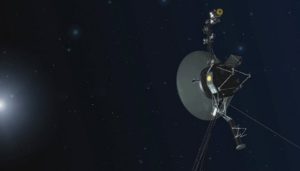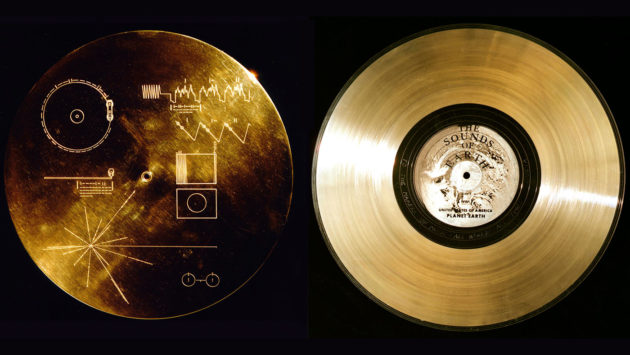NASA engineers directed the historic spacecraft Voyager 1 to activate its backup thrusters after 37 years of disuse.

NASA-JPL
Flashback to 1980: Jimmy Carter was president, M*A*S*H and Magnum P.I. were hot TV shows, and 5 megabytes was considered a lot of computer memory.
It was also the last time that Voyager 1 used its four backup thrusters, during its brief flyby past Saturn's large moon, Titan.
That long dormancy came to an end on November 28th, when Voyager 1 test-fired its four backup Trajectory Course Maneuvering thrusters for the first time in 37 years. The thrusters fired in short, 10-millisecond bursts. The signal that the spacecraft had performed the maneuver, which had to travel for 19 hours and 35 minutes back to Earth, successfully arrived at the Deep Space Network in Goldstone, California, on November 29th.

NASA
“With these thrusters that are still functional after 37 years without use, we will be able to extend the life of the Voyager 1 spacecraft by two to three years,” says Suzanne Dodd (NASA-JPL) in a recent press release.
Saving Voyager
Voyager 1 periodically uses its main attitude control thrusters to keep its communications antenna aimed at Earth. However, engineers have noticed that the aging thrusters had degraded since 2014, requiring longer burns to generate the same amount of energy. So they came up with a solution: use the long dormant Trajectory Course Maneuvering (TCM) thrusters for attitude control.
Identical in size and shape to the main attitude-control thrusters, the four TCM thrusters are located on the back of the spacecraft. Built by Aerojet Rocketdyne , they were used during the hectic Jupiter and Saturn encounters to ensure that the spacecraft's instruments pointed at the two gas giants and their respective moons. The final use of the TCMs came on November 8, 1980, leading up to the planned Titan encounter four days later, a trade-off maneuver that also ejected Voyager 1 out of the plane of the solar system.
Those early burns used the TCM thrusters in a continuous firing mode. Voyager 1 had never used them in short bursts for spacecraft orientation. The new plan sent engineers digging back through old Voyager data and software, much of which was coded in a assembler programming language as old as the thrusters themselves.
The test firing was a success. Engineers now plan to start using the TCM thrusters for primary spacecraft orientation control in January 2018, and they might instruct Voyager 2 to do the same. According to Enrique Medina (NASA-JPL), Voyagers 1 and 2 have 14 and 23 kilograms of hydrazine propoellant remaining, respectively.
The plan is not, however, without its drawbacks. The thrusters need heat to operate, and turning on extra spacecraft heaters, one for each thruster, draws energy from the power supply, a plutonium-238-fueled Radioisotope Thermoelectric Generator. The half-life of plutonium-238 is 88 years, and the mission has just reached its 40th-year anniversary. Still, when there is no longer extra power to heat the TCM thrusters, the team plans to switch back to the main thrusters for future adjustments.
The Voyager Legacy
Voyager 1 was actually launched two weeks after Voyager 2, on September 5, 1977. It's currently the most distant human spacecraft ever fielded, more than 141 times the Earth-Sun distance (astronomical units, or a.u.) from the Sun and counting. The spacecraft is flying away from our solar system at 17 kilometers per second in the direction of the constellation Ophiuchus. It crossed the boundary into interstellar space in August 2012, as reckoned by the sudden decrease of solar-wind particles and a corresponding increase in cosmic-ray particles. The abrupt change marked the spacecraft's crossing of the heliopause, the bubble carved out by the solar wind.

NASA/JPL-Caltech
Voyagers 1 and 2 both carry the iconic Golden Records as they travel. Carl Sagan and Ann Druyan designed the records as a message to any future interstellar salvagers, with the sounds of Earth on one side and instructions for playback, as well as the location of our solar system in the Milky Way, on the obverse side. The record cover is even plated with uranium-238, which has a half-life of 4.5 billion years, a clue discoverers can use to date its manufacture.

Heavens-Above
Voyagers 1 and 2 are two of five spacecraft on an escape trajectory out of the solar system — Pioneers 10 and 11 and New Horizons are also on their way out.
Fun fact: The first recently discovered rock from interstellar space, 1I/2017 U1 'Oumuamua, will overtake all of these spacecraft as it, too, leaves the solar system. It'll pass Voyager 1 in 2083, although unlike Voyager 1, 'Oumuamua is moving in the direction of the constellation Pegasus. (Check out Tony Dunn's simulation to watch it happen.)
Maybe, one day, we could encounter "alien voyagers" — it's a fun thought experiment anyway! In the meantime, it's amazing that, 40 years after launch, the two Voyager spacecraft are still able to communicate with Earth about their travels.
 3
3









Comments
Graham-Wolf
December 5, 2017 at 8:10 pm
WOW!!
Tremendous news!
Well done:- Voyager.
I'm soooo impressed (no... make that:- "gob-smacked").
Graham W. Wolf at 46 South, Dunedin, NZ.
You must be logged in to post a comment.
Spencer R. Rackley IV
December 6, 2017 at 11:48 pm
I used to code in IBM 360 Assembler. I wonder if they need anyone?
You must be logged in to post a comment.
opalko
December 30, 2017 at 8:49 am
It's Ann Druyan, not Dryan.
You must be logged in to post a comment.
You must be logged in to post a comment.